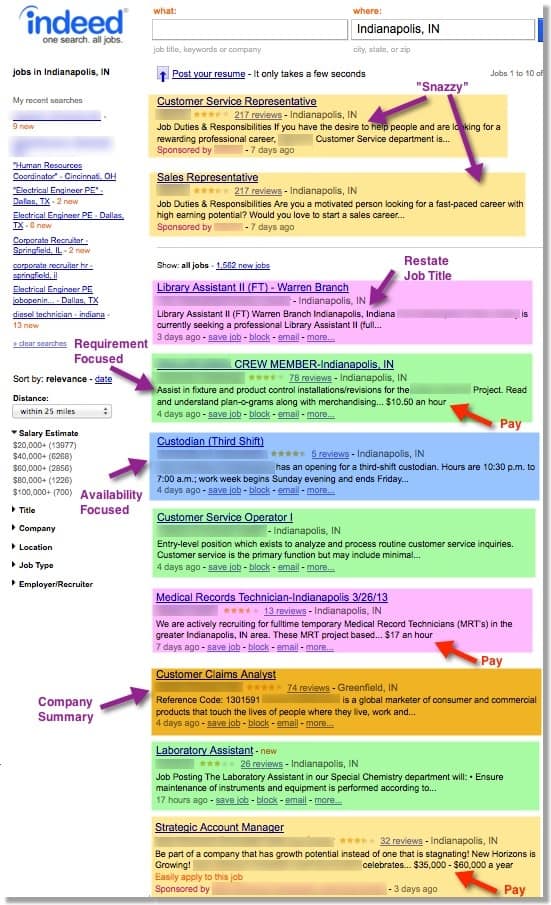How to Write Job Descriptions Optimized for Job Boards and Internet Search, Tip 2
It’s pretty easy to find advice about writing compliant job descriptions, but it can be harder to make sure those same descriptions translate into engaging blurbs on job board search results pages…that is, blurbs or “snippets” that are guaranteed to pique the interest of your potential applicants as they pore over pages of competitive job listings. But, there isn’t a single right away to approach writing job listings for search; in fact, crafting effective, “crawlable” job descriptions for your organization is largely dependent on the labor market for your position, your applicant demographic, organizational culture and whether or not you pay to sponsor your ads on otherwise free boards — such as Indeed. In this second installment of this “How to Write Job Descriptions Optimized for Job Boards & Internet Search” blog series, I’ll specifically discuss how to take a situational approach to writing the first few lines of a job description.
Use Smart Snippets
Let’s start off by looking at some general search results on the first page of a search for jobs in Indianapolis, IN. In particular, examine the snippets (also called meta descriptions) that summarize the first sentence or two under each position title. Unless the author of a web page specifically designates a meta description in the source code, then search engines and job boards will pull the first line or two of body text from your page. In my experience, the latter is the norm in the case of job listing search results.

As you can see, the job listing content included in each snippet varies with position. Whether or not the approach employed by each organization will work depends, again, on the job’s demand, demographic, culture and pocketbook. Take a closer look…
Consider Labor Market for Your Jobs
If sourcing applicants with the right qualifications, and availability to work, for one of your positions is comparable to spotting Sasquatch in your backyard, then you probably have some labor market-related considerations to examine. For example, if your position type is super easy to stumble upon in search results (i.e. there are hundreds with the same job title), and especially if the minimum qualifications do not require advanced professional degrees or experience, then one of your biggest applicant screening filters may be the days and times of the week that individuals are available to work.
With that in mind, the best job listing introduction might be a summary of the shift days and hours, as in the blue highlighted example from our sample search results. This works especially well if the employment application process for this position also includes questions designed to elicit responses from applicants on whether they meet basic minimum qualifications. For example, whether the applicant has the ability to work a certain shift on certain days might be an appropriate question. Ask your applicant tracking system provider about using scoring and disqualification filters on these types of questions to streamline the applicant screening process.

For frequently posted positions where hours aren’t the screening focus, it is good practice to restate the title of the job listing in the first sentence. This technique isn’t as much about engaging applicants as it is about increasing the frequency of desired keywords (more on this in a future post) — see pink highlighted examples. The more often you include the job title and/or similar names (up to a certain reasonable point), the more likely your job listing will rank higher in the list of results for an applicant searching using that keyword.
Know Your Target Applicant Pool
Think about your dream candidate for a specific position. How savvy is he/she at web search? Will he/she think beyond just searching for job titles, and also search for specific duties or required certifications associated with your job listing? Or, even if an applicant won’t necessarily search for those terms, he/she might be more likely to click on your job listing in search results if your snippet displays a reference to an essential job requirement that he/she finds appealing. This is another way to differentiate your listing from other job postings that don’t discuss duties until later in the full job description. So, while the two below listing results are for different types of positions, which one gives you more actual, engaging information about the job at a quick glance? And a glance is often all you have in today’s recruiting landscape…


If you picked the green job listing over the orange one, then you get the recruiting gold star for the day! If you picked the orange one, then check out tips on company summary placement in How to Write Job Descriptions Optimized for Job Boards & Internet Search, Part 1.
Be Snazzy If You Sponsor
As with all aspects of the talent acquisition process, the organizational culture of your company should shape your approach to writing job descriptions, as well. If part of your recruiting brand is to be energetic and fun, then you might want to take a more informal approach to writing the text of some of your job descriptions. Think about the behavioral characteristics of candidates who will thrive in the position that you are posting. Will they be persuaded to click and eventually apply to a snazzier, more tantalizing description of your organization and/or the position? Probably. Most people do aspire to like the work they do, after all. I especially see this approach with sales positions – which makes sense since persuasion is often a coveted skill for a successful business development employee.
However, if you are relying on this approach to carry you to the top of organic (i.e. unpaid) search results on search engines and job boards, make sure you carefully account for the prominence of your organization’s name and how difficult it is to fill this type of position in your decision making process. Take note of the yellow highlighted positions in our search results…one thing they all have in common is that they are sponsored ads and so their placement, or the ease with which someone may apply, earns premium attention. If your strategy or plan for a job posting does NOT include paying for special status, then you’ll likely be more heavily reliant on using relevant keywords and job information in your first few lines of text.

A Parting Thought on Pay
If you didn’t notice already, some of the snippets in our sample search results included information about the compensation for the position. However, that doesn’t always mean that the first few lines of the position description include pay info. In fact, if the compensation information is preceded by an ellipsis (…) in the snippet, then you know that the job board or search engine just appended that information after finding it somewhere else in the full job listing. The job board is really helping you out by displaying your opportunity in such a way that many job-seekers will self-select out of your application process because they have a different income expectation. However, as you consider how your job description preview will appear in search result snippets, know that if you do include salary or hourly wage information in your listing, it will likely appear in the snippet; thus, shortening the text displayed from the beginning of your description.

Now that you are familiar with the different techniques organizations may use to engage potential applicants in the snippet area of search results, it is time to evaluate your own job listings, applicant pool, culture and budget to determine which method will suit your needs. Be on the lookout for future blogs in this series that discuss choosing job posting titles and keywords.
In search of a tool that makes it easy to post job listings to external job boards and search engines? Schedule a live demo of our applicant tracking software (ATS) today!








